Teaching chickens to roost is a fundamental aspect of raising a flock, ensuring their safety, comfort, and overall well-being. Roosting is a natural behavior for chickens, but they may need guidance, especially if they’re young or have been raised in an environment that didn’t facilitate roosting.

Roosting not only keeps chickens off the ground, away from potential predators and dampness but also promotes better sleep quality and overall health. In this comprehensive guide, we’ll delve into the various techniques and strategies for how to teach chickens to roost.
From selecting appropriate roosting materials and heights to creating a conducive environment within the coop, there are numerous factors to consider. By understanding the innate behaviors of chickens and implementing gentle and patient training methods, poultry enthusiasts can successfully encourage their feathered friends to embrace the roosting habit, ensuring a harmonious and thriving flock.
Importance of Teaching Chickens to Roost
Teaching chickens to roost plays a critical role in their development and overall health, marking an essential task for every poultry keeper. Firstly, roosting mimics the natural instinct of chickens to seek higher ground for nighttime safety, protecting them from ground-level predators and damp conditions that can lead to health issues.
It also promotes cleanliness, as chickens are less likely to come into contact with their own waste, reducing the risk of diseases spreading through the flock. Furthermore, the act of roosting supports the social hierarchy within the flock, as chickens establish their pecking order based on roosting positions. This social structure is vital for maintaining peace and reducing stress among the birds.
Additionally, roosting bars help chickens’ feet stay healthy by preventing deformities and promoting natural wear down of their nails. Overall, encouraging this natural behavior is fundamental to ensuring the wellbeing of chickens, fostering a safe and stress-free environment that contributes to the longevity and happiness of the flock.
Understanding Roosting Behavior
Roosting behavior in chickens is largely driven by their instinct for safety and comfort during the night. At sundown, chickens instinctively seek a high perch to spend the night, away from predators and ground-level threats. This behavior mimics their wild ancestors who roosted in trees to avoid danger. Understanding this natural inclination is key to effectively teaching them to roost in a designated area within the coop.
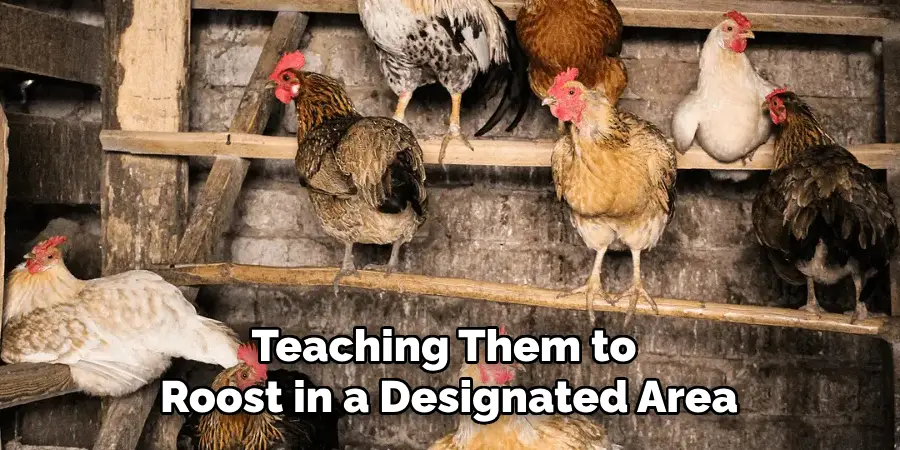
Chickens are also very routine-oriented animals. Once they adapt to a specific roosting spot, they are likely to return to it or nearby areas every night. This habitual nature can be leveraged when training chickens to roost, as consistency in the roosting environment and routine can significantly ease the process.
The social dynamics of roosting cannot be overlooked. Chickens establish a pecking order, and this hierarchy is often reflected in roosting positions, with higher-ranking chickens occupying the higher perches. Recognizing these dynamics is essential for poultry keepers to manage the flock’s social structure effectively and ensure a harmonious roosting environment.
In essence, a deep understanding of these natural behaviors and social structures is crucial for anyone looking to teach chickens to roost successfully. By accommodating these instincts and routines, keepers can create a roosting environment that feels natural and safe for their chickens, encouraging them to adopt the desired behavior seamlessly.
Natural Instincts of Chickens to Roost
The natural instincts of chickens to roost are deeply ingrained behaviors that have evolved over thousands of years. At the heart of these instincts is the drive for safety and security. In the wild, the ancestors of domestic chickens would roost in trees to protect themselves from predators and environmental hazards. This instinctual behavior is still present in modern chickens, regardless of whether they are kept as backyard pets or on larger farms.
When dusk approaches, chickens are naturally inclined to seek out a high perch. This behavior can be observed even in very young chicks. The preference for elevation while sleeping serves two main purposes: it keeps them safe from ground-level predators and elevates them off cold, damp ground, thereby protecting them from potential health issues.
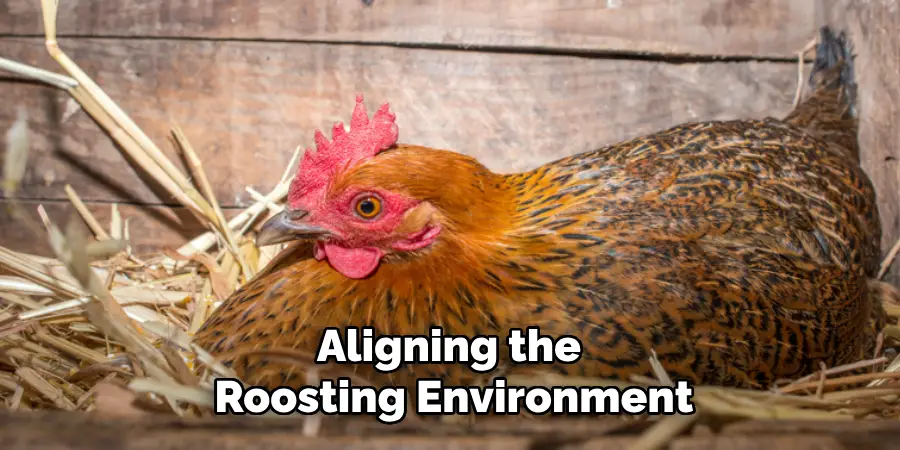
Understanding this intrinsic need for elevation and security is crucial for anyone wishing to encourage roosting behavior within a domestic setting. Providing a perch that simulates the safety of a tree branch can tap into these natural instincts, making the training process more intuitive for the chickens. By aligning the roosting environment with their inherent needs, keepers can facilitate a more natural adoption of roosting practices, ensuring the chickens feel secure and comfortable in their surroundings.
Anatomy of a Roosting Bar
The design and setup of a roosting bar are crucial to successfully training chickens to roost and ensuring their comfort and safety. A well-constructed roosting bar considers the physical needs of chickens and their natural behaviors. The following elements comprise the anatomy of an effective roosting bar:
- Material: The most common materials for roosting bars are wood and metal, with wood being preferred due to its insulation properties. Metal can become too cold in winter, potentially causing discomfort or frostbite to the chickens’ feet. The wood should be smooth and free of splinters to protect the chickens’ feet.
- Diameter: The ideal diameter for a roosting bar is between 2 to 4 inches, depending on the size of the chickens. This size allows chickens to comfortably wrap their feet around the bar and maintain balance. For larger breeds, a wider diameter may be necessary.
- Length: The length of the roosting bar should accommodate all the chickens in the flock, allowing for about 8 to 10 inches of space per chicken. This spacing helps prevent pecking and crowding during the night.
- Height: While chickens prefer a higher perch for safety reasons, the roosting bar should be at a height that allows them to easily hop up without struggle. Typically, a height of 2 to 4 feet off the ground is suitable, depending on the breed and age of the chickens.
- Placement: Roosting bars should be placed in the highest, most secure area of the coop to align with the chickens’ instinct to roost in a high spot. They should also be positioned away from the walls to prevent chickens from being cramped and to minimize droppings on the coop walls.
- Configuration: If multiple roosting bars are used, they should be staggered at different heights to prevent droppings from falling on chickens roosting below. However, make sure the bars are not directly over food or water sources to maintain cleanliness.
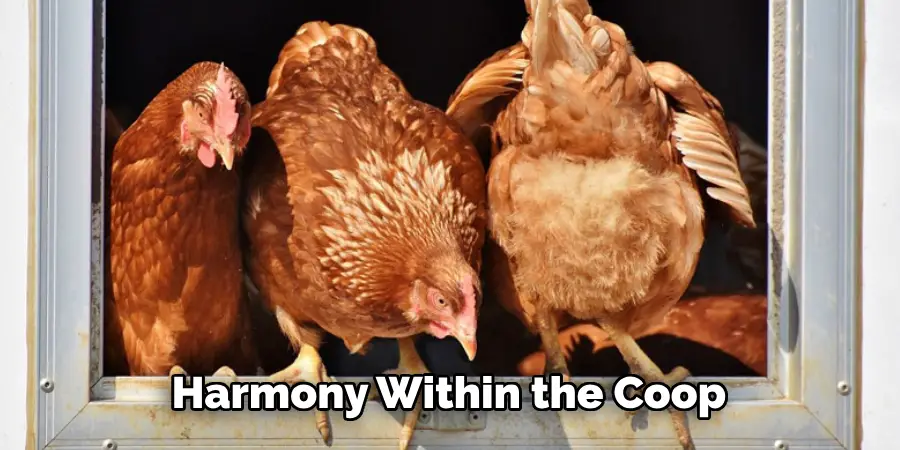
A properly designed and positioned roosting bar not only satisfies the natural instincts of chickens to roost at an elevated level but also promotes order and harmony within the coop by accommodating the social hierarchy.
Factors Influencing Roosting Behavior
Several factors influence the roosting behavior of chickens, from environmental conditions to their physical health. Understanding these factors can assist poultry keepers in creating a conducive roosting environment and managing their flock effectively.
- Lighting: Chickens are influenced by natural light cycles, with roosting behavior typically beginning at dusk. Artificial lighting in the coop can disrupt their natural roosting patterns, so managing light exposure to mimic natural conditions is essential for their well-being.
- Safety and Protection: Chickens need to feel safe from predators and environmental elements. Coops that are secure and provide shelter from the elements encourage natural roosting behavior. Any perceived threat or discomfort can deter chickens from using the designated roosting area.
- Health Issues: Physical health plays a crucial role in roosting behavior. Chickens suffering from parasites, foot injuries, or other health-related issues may find roosting uncomfortable or challenging, leading to abnormal roosting patterns or avoiding the roost altogether.
- Age and Breed: Young chicks and certain breeds may require specific accommodations for roosting. For instance, younger or smaller breeds might struggle with higher perches, and as such, lower or adjustable roosting bars can promote more natural roosting behavior.
- Social Stress: The social environment within the flock can significantly affect roosting behavior. Bullying or aggression can lead to stress and displace lower-ranking chickens from preferred roosting spots. Managing the flock dynamics to minimize stress is crucial for a harmonious roosting environment.

By taking these factors into account, poultry keepers can better understand and influence the roosting behavior of their chickens, ensuring a comfortable and natural roosting process for the entire flock.
Size and Placement of Roosting Bars
The size and placement of roosting bars within a chicken coop are essential for promoting a healthy and comfortable environment for the chickens. The dimensions and configuration of these bars should cater to the specific needs of the flock, considering their size, breed, and social hierarchy. Here are some considerations for ensuring the optimal size and placement of roosting bars:
- Bar Size: The diameter of the roosting bars should be suitable for the chicken’s feet to grasp comfortably, ideally between 2 to 4 inches. Ensuring the bar is not too large is crucial for preventing foot strain, whereas bars that are too small can cause balancing issues and discomfort.
- Bar Length: Each chicken should have enough space to roost without feeling crowded. Providing at least 8 to 10 inches of space per chicken is recommended. This spacing helps to reduce stress and pecking among the flock during the night.
- Placement Height: The height of the roosting bars should enable the chickens to hop onto them easily. A height of 2 to 4 feet from the coop floor, depending on the breed and mobility of the chickens, is ideal. This allows for a feeling of security while not being too challenging for them to access.
- Coop Positioning: Placing roosting bars in the highest and safest area of the coop is important. Chickens naturally seek high ground for sleeping to stay away from predators, so the roosting bars should be the highest available point within the coop.
- Distance from Walls: To prevent chickens from feeling cramped and to reduce the accumulation of droppings on the coop walls, roosting bars should be positioned away from the walls. A distance that allows for adequate airflow and movement around the bars is ideal.
- Multiple Levels: If using multiple roosting bars, they should be staggered at different heights to minimize droppings on chickens below and to cater to the social hierarchy within the flock. Ensure there is enough vertical and horizontal space between bars to prevent conflicts and allow for easy access and egress.

Properly sized and positioned roosting bars are critical for ensuring the well-being of your chickens. They contribute to the overall orderliness and hygiene of the coop environment, while also aligning with the chickens’ natural instincts for safety and comfort.
10 Methods How to Teach Chickens to Roost
1. Provide Proper Roosting Bars:
The foundation of teaching chickens to roost lies in providing appropriate roosting bars. Choose sturdy bars made of wood or metal that are at least 2 inches wide, with rounded edges to prevent discomfort for the chickens. Install the bars at a height of about 18 inches off the ground, with enough space between each bar to accommodate all the chickens comfortably.
2. Place Roosting Bars at the Right Height:
Chickens prefer roosting at higher elevations to feel safe from predators. Ensure that the roosting bars are positioned at the correct height, slightly higher than the nesting boxes and away from any potential drafts. This encourages chickens to naturally gravitate towards the roosting bars at night.
3. Create a Cozy Environment:
Make the roosting area inviting by providing clean and comfortable bedding material on the roosting bars. Use materials like pine shavings or straw that absorb moisture and provide insulation against cold temperatures. Replace the bedding regularly to maintain cleanliness and freshness.
4. Establish a Routine:
Chickens thrive on routine, so establish a consistent bedtime routine to encourage roosting behavior. Close the coop at dusk to encourage chickens to roost inside rather than seeking alternative roosting spots. Similarly, open the coop at the same time each morning to signal the start of the day. This will help your chickens develop a natural sleeping pattern and feel more secure in their environment.
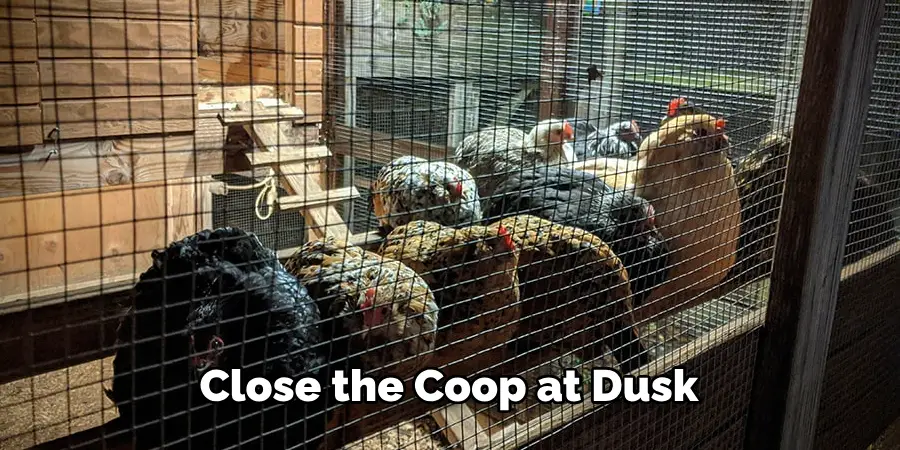
A consistent routine also extends to feeding times. Chickens should be fed at the same time each day, preferably in the morning. This not only helps with digestion but also allows you to monitor their feed intake and make adjustments as needed.
5. Use Positive Reinforcement:
Encourage chickens to roost by rewarding them with treats or praise when they successfully roost on the bars. Place treats on the roosting bars or near the entrance of the coop to entice them to explore the area. Positive reinforcement helps reinforce desired behavior and makes roosting a positive experience for the chickens.
6. Mimic Natural Roosting Conditions:
Mimic outdoor roosting conditions inside the coop to make chickens feel more comfortable and secure. Add branches or natural perches to the roosting bars to simulate the feel of roosting in trees. This can help chickens feel more at ease and encourage them to roost instinctively. You can also add nesting material, such as straw or shredded paper, to create a cozy and inviting roosting spot for your chickens.
7. Provide Adequate Space:
Ensure that there is enough space on the roosting bars for all the chickens in the flock to roost comfortably without overcrowding. If space is limited, consider adding additional roosting bars or expanding the existing ones to accommodate the entire flock. Overcrowding can lead to competition and aggression, discouraging roosting behavior.
8. Monitor and Redirect Nesting Behavior:
Chickens may sometimes confuse roosting bars with nesting boxes, especially if they are similar in height and design. Monitor the coop regularly and gently remove any chickens found nesting on the roosting bars, redirecting them to the nesting boxes instead. Provide comfortable bedding in the nesting boxes to encourage egg-laying behavior.
9. Gradual Introduction to Roosting Bars:
For young chicks or newly introduced chickens, introduce them to the roosting bars gradually to help them feel comfortable and confident. Place them on the roosting bars during the day and encourage them to explore the area. As they grow more accustomed to the roosting bars, they will be more likely to roost on them at night.
10. Be Patient and Consistent:
Teaching chickens to roost requires patience and consistency. Not all chickens will immediately take to roosting, and some may require more time and encouragement than others.
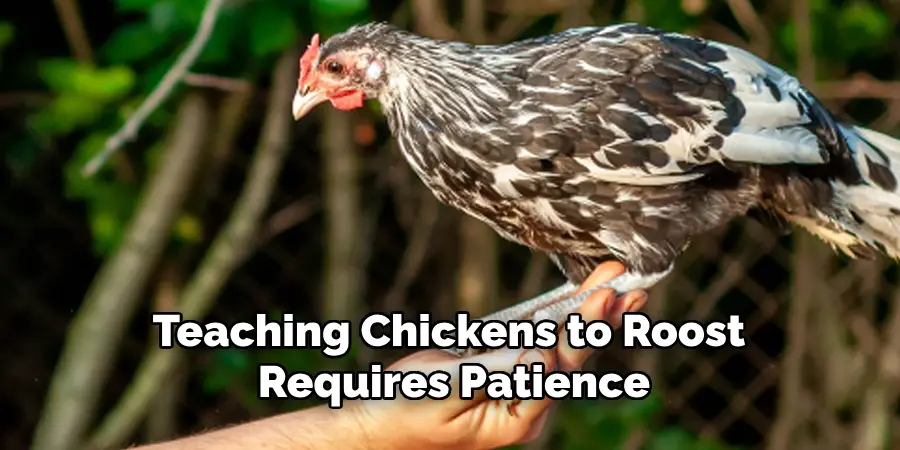
Be patient and continue to reinforce roosting behavior through positive reinforcement and environmental adjustments. With time and consistency, most chickens will eventually learn to roost on their own.
Conclusion
In conclusion, teaching chickens to roost is a rewarding endeavor that fosters a sense of safety, comfort, and well-being within your flock.
By understanding the natural instincts of chickens and providing them with the appropriate environment and guidance, poultry keepers can effectively instill the roosting habit in their birds. Patience, consistency, and a gentle approach are key to success in this endeavor, as chickens may require time to adjust to new routines and surroundings.
However, the benefits of roosting are manifold, ranging from protection against predators and dampness to promoting better sleep quality and overall health. Thanks for reading, and we hope this has given you some inspiration on how to teach chickens to roost!
You Can Check It Out to
About
Outdoor Fixes is a distinguished figure in the world of Diy design, with a decade of expertise creating innovative and sustainable Diy solutions.
His professional focus lies in merging traditional craftsmanship with modern manufacturing techniques,
fostering designs that are both practical and environmentally conscious. As the author of diy,
outdoorfixes delves into the art and science of outdoorfixes-making, inspiring artisans and industry professionals alike.
Education RMIT University
(Melbourne, Australia) Associate Degree in Design (Outdoor Fixes) Focus on sustainable design, industry-driven projects,
and practical craftsmanship. Gained hands-on experience with traditional and digital manufacturing tools, such as CAD and CNC software.
Nottingham Trent University
(United Kingdom) Bachelor’s in outdoorfixes.com and Product Design (Honors) Specialized in product design with a focus on blending creativity with production
techniques. Participated in industry projects, working with companies like John Lewis and Vitsoe to gain real-world insights.
Publications and Impact
In diy, Outdoor Fixes his insights on indoor design processes, materials, and strategies for efficient production.
His writing bridges the gap between artisan knowledge and modern industry needs, making it a must-read for both budding designers and seasoned professionals.

